UC Master Gardeners of Napa County answer garden questions at our Help Desk on Mondays, Wednesdays, and Fridays from 9:00 a.m. - 12 noon. Free advice is given for growing conditions in Napa County and there are three ways to contact us:
Drop-in: UC Cooperative Extension-Napa County, 1710 Soscol Avenue, Ste 4
By phone:
707-253-4143
877-279-3065 (toll free for American Canyon/Up valley residents)
Complete the diagnosis form or e-mail mastergardeners@countyofnapa.org
The Help Desk fields a range of questions. Thanks to UC Master Gardener Monica Finigan for writing about the following recent inquiries to the Help Desk.
Strange-looking Strawberries: Client called about the strange-looking strawberries growing on his strawberry plant. The strawberries looked “hairy.” They had small leaves sprouting around the seeds on the fruit. The strawberry plants had been growing in a wine barrel for eight years. This strange appearance is called a “phylloid.” Although there are several possible causes, the recommendation was to destroy the plants and plant new strawberries in new soil and in a different location. Strawberries are subject to several soil borne diseases and should be replaced every three years (or sooner if needed) and planted in a new location.
Meyer Lemon: Client called to ask why her Meyer lemon had not borne fruit. Her tree is four feet tall. She did not know the age as she “inherited” the tree from someone. She also indicated that it did not look good when she received it, so she pruned it during the summer. There are many possible reasons for its failure to bear. She may have pruned off the buds or the tree might not have had buds due to insufficient watering, lack of nutrients, not enough exposure to sunlight, or because it is a young tree. Citrus bear little or no fruit during their first three-to-four years.
Yellow leaves on Meyer Lemon: Client called regarding yellow leaves on a Meyer Lemon tree. Patterns of yellowing on the leaves can be an indication of a nutrient deficiency. The most common nutrient deficiency in lemons is a lack of nitrogen. The most important time to apply fertilizer is late winter or early spring, but application can also be divided into three times during the year for lemons. Fertilizer needs to be scattered over the entire root area of the tree, which extends one to two feet beyond the drip line. Consult the application directions on the fertilizer package.
Mysterious Orange Growth in Mulch: Client called to ask about a bright orange “something” in his mulch. Should he be worried about it? He was told that it was probably a fungus or slime mold. Most fungi are decomposers, and he should not be concerned, but he should make sure that a child or pet doesn’t eat it. He later called back to say he had looked more closely and the orange growth appeared to be a cluster of small mushrooms.
Flies in Walnut Husks: Client reported that there was an infestation of flies in the walnut husks of his tree, and the husks were stained black. Walnut husk flies primarily damage the husks and the walnut shell. Generally, the flies do not damage the nutmeats. The damaged husks can be placed in a damp burlap bag for a few days before attempting to remove the hull. Infested husks should be disposed of in a tightly sealed bag. Good sanitation can help reduce the number of husk flies overwintering nearby. Remove and dispose of damaged nuts as soon as possible. Spread a tarp under the tree from July through August to prevent the maggots from entering the soil to pupate. For severe infestations, spinosad can be sprayed on a 7-to-14 day interval beginning in July until within one month of harvest. Adding a bait to the spray would eliminate the need to cover the entire tree since the flies would be attracted to the bait and would eat the spray. The home gardener might want to consider using molasses as the bait (4-to-6 tablespoons per gallon of water) and always follow label instructions.
Olive Fruit Fly: Client requested information on preventing a re-infestation of olive fruit fly on her trees. Her neighbor leaves the olives on his tree every year. She also wanted to know how to dispose of the infected fruit. Management of this problem will be a challenge with an uncooperative neighbor. Infected fruit can either be disposed of at the landfill or buried in the ground, at least four inches below the surface. In the following year, a combination of bait traps to reduce the population and application of barrier film sprays on the trees should be considered. The barrier film should be applied as the flies begin to attack the fruit in late summer. See Pest Note 74112 for more information.
Growing Crocus: Client wanted to know if crocus bulbs need to be pre-chilled before planting and whether crocus bloomed for only one day. Bulbs do not need to be pre-chilled in the SF Bay area. Crocuses bloom for an extended period of time, not just for one day. They do well in this area, since crocuses originated in the Mediterranean area.
